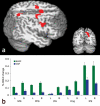Neural bases of selective attention in action video game players
- PMID: 21864560
- PMCID: PMC3260403
- DOI: 10.1016/j.visres.2011.08.007
Neural bases of selective attention in action video game players
Abstract
Over the past few years, the very act of playing action video games has been shown to enhance several different aspects of visual selective attention, yet little is known about the neural mechanisms that mediate such attentional benefits. A review of the aspects of attention enhanced in action game players suggests there are changes in the mechanisms that control attention allocation and its efficiency (Hubert-Wallander, Green, & Bavelier, 2010). The present study used brain imaging to test this hypothesis by comparing attentional network recruitment and distractor processing in action gamers versus non-gamers as attentional demands increased. Moving distractors were found to elicit lesser activation of the visual motion-sensitive area (MT/MST) in gamers as compared to non-gamers, suggestive of a better early filtering of irrelevant information in gamers. As expected, a fronto-parietal network of areas showed greater recruitment as attentional demands increased in non-gamers. In contrast, gamers barely engaged this network as attentional demands increased. This reduced activity in the fronto-parietal network that is hypothesized to control the flexible allocation of top-down attention is compatible with the proposal that action game players may allocate attentional resources more automatically, possibly allowing more efficient early filtering of irrelevant information.
Copyright © 2011 Elsevier Ltd. All rights reserved.
Figures







References
-
- Beauchamp M, Cox R, DeYoe E. Graded effects of spatial and featural attention on human area MT and associated motion processing areas. Journal of Neurophysiology. 1997;78(1):516–520. - PubMed
-
- Beauchamp MH, Dagher A, Aston JAD, Doyon J. Dynamic functional changes associated with cognitive skill learning of an adapted version of the Tower of London task. NeuroImage. 2003;20(3):1649–1660. - PubMed
-
- Beck DM, Lavie N. Look here but ignore what you see: effects of distractors at fixation. Journal of Experimental Psychology: Human Perception and Performance. 2005;31(3):592–607. - PubMed
-
- Beckmann C, Jenkinson M, Smith SM. General multi-level linear modelling for group analysis in FMRI. NeuroImage. 2003;20:1052–1063. - PubMed
Publication types
MeSH terms
Grants and funding
LinkOut - more resources
Full Text Sources
Research Materials
Miscellaneous

